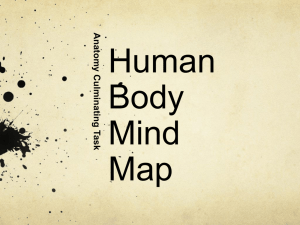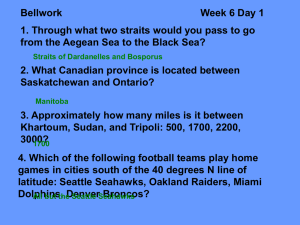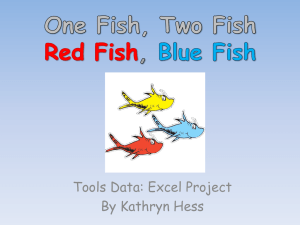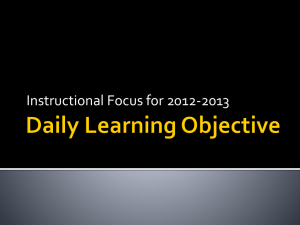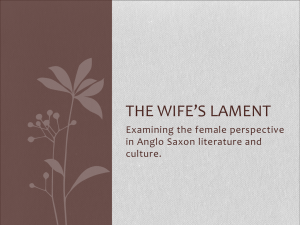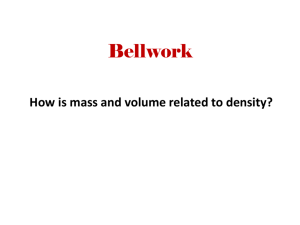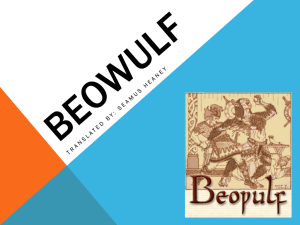CM-2-Bellwork
advertisement
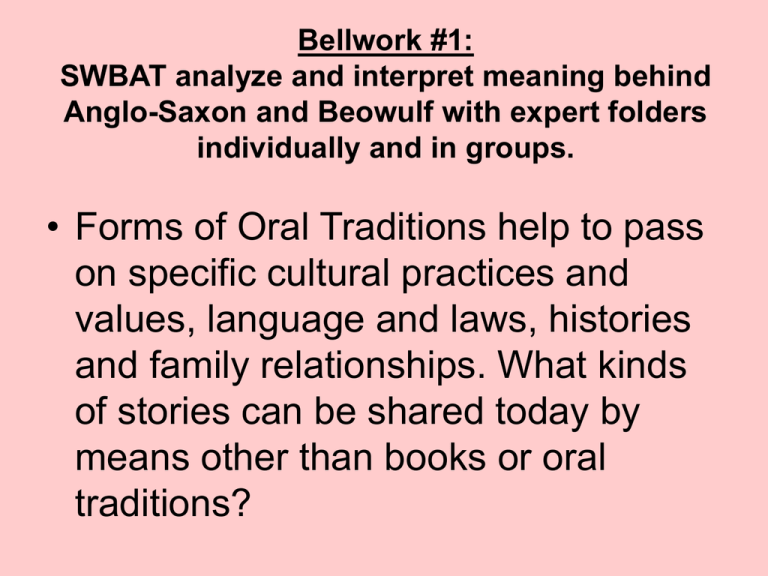
Bellwork #1: SWBAT analyze and interpret meaning behind Anglo-Saxon and Beowulf with expert folders individually and in groups. • Forms of Oral Traditions help to pass on specific cultural practices and values, language and laws, histories and family relationships. What kinds of stories can be shared today by means other than books or oral traditions? Bellwork #2: SWBAT analyze and interpret meaning behind Anglo-Saxon and Beowulf with expert folders individually and in groups. • Beowulf was originally an oral tale. How does telling a story out loud keep it alive? Bellwork #3: SWBAT discuss and interpret meaning of notes through a gallery walk. SWBAT take and discuss guided notes on Beowulf. • Think about a hero you know or have read about. Write down a situation in which a person can rise above his or her place in life to become a hero. Bellwork #4: SWBAT annotate the first part of Beowulf and discuss the meaning as a class. • List 3 things you have learned about Beowulf from your Gallery walk Bellwork #5 SWBAT discuss and interpret the AoW and apply SOAPTONE. SWBAT apply and SSR log to SSR reading time. • What is the importance of group loyalty? How can these loyalties conflict with individual needs or desires? Bellwork #6: SWBAT analyze a clip from a video on loyalty to discuss loyalty to a family vs. loyalty to society. • • • • • Watch the clip from the video. What would you do if… What do you think the father will do? What does he do? List three reasons why you think he makes this decision? Bellwork #7: SWBAT analyze the AoW and apply 4 square to it and use SSR time to apply it to a log. • How do languages around the world differ from English? • How has the English language changed over the years? Bellwork #8: SWBAT analyze vocabulary that will be used within this unit, apply the Frayer model to them, and share out with the class. Look on pages 23-24 in your green literature books. List 3 words that look unfamiliar to you and from the information on the page, see if you can find the meaning of them and write them down. Bellwork #9: SWBAT analyze and interpret a narrative text and apply the 4 square method to it. • For this bellwork, write 4 square review. Bellwork # 10: SWBAT interpret meaning behind the 1st section in Beowulf, The Monster Grendel and The arrival of the Hero. • What do you predict this story is going to be about? • Who will be the hero? • What is their tragic flaw? How can this work against them? For them? Bellwork #11: SWBAT critically read Unferth’s Challenge and kook for examples of metaphor’s, alliteration, similes, and Kennings. • Create a double-bubble map on Beowulf and Grendel. Don’t forget your frame and your question. Bellwork #12: SWBAT Critically read and discuss The Monster’s Mother and work in Lit groups to answer and discuss review questions. • Create a Flow Map based on at least 5 main events that happened in Battle with Grendal. Add at least 2 details behind each event. Don’t forget your frame of reference. Your question should be: What happened in the battle with Grendal? Bellwork #13: SWBAT Review Part 1 of Beowulf and then apply the concepts to a quiz. SWBAT create a 4 stanza poem with a hero who has a strength and weakness. • Beowulf exclaims, “Fate will unwind as it must!” What can you infer about Beowulf’s beliefs from this statement? Bellwork 14: SWBAT critically read and analyze the final battle. SWBAT identify metaphore, similes, alliteration, and any Kennings used thoughout this section. Beowulf has successfully ruled and reigned for 50 years over the Geats. This is his final battle, what do you predict will happen and why? Remember he is an old man now…what would make him still battle at this point, when he has other’s that can do it for him? Bellwork #15: SWBAT create a double-bubble based upon the epic in the book version and the movie version. SWBAT analyze Beowulf based upon the characteristics of an epic hero, how they see them used within Beowulf and apply them to a paper. • In what way does Wiglaf resemble the younger Beowulf? What makes him a worthy successor to Beowulf? Bellwork #16: SWBAT create a double-bubble based upon the epic in the book version and the movie version. SWBAT analyze Beowulf based upon the characteristics of an epic hero, how they see them used within Beowulf and apply them to a paper. What characteristics make Beowulf an epic hero. Create a Bubble-Map, put Beowulf as an epic hero in the center, list examples and qualities that make him an epic hero around the main idea. State at least 5. Bellwork #17: SWBAT apply concepts of Beowulf to their rough draft of their paper while they finish watching the movie. • What version did you like better, the story in the book or the movie? Why? Bellwork #18: SWBAT Review Beowulf for a test on Wednesday and discuss project ideas. • .Create a flow map of Beowulf that include the main plot points in a sequence of events. No Bellwork: Take 5 mins and look over your notes and study guide. Turn in your study guide if you did it. Bellwork #19: SWBAT critically read and discuss The Illiad and how it compares to Beowulf. • Create a circle map with the center idea as The Iliad, write down everything you know about it. Don’t forget your frame of reference and your question. Bellwork #20: SWBAT critically read and discuss The Illiad and how it compares to Beowulf. SWBAT view a clip of Troy and relate it to Beowulf. • Create a double-bubble comparing the Iliad to Beowulf. Don’t forget a frame of reference and a question. Bellwork #21: SW demonstrate their understanding of Academic vocabulary using the following terms in a sentence. SW read and annotate an article about Chaucer and apply characteristics about the author to a bubble map. SW read and listen to the prologue of the CT and discuss the meaning behind it orally. • • • • • • Eminent (adj.): Great or high standing. Guile (n.): Sly dealings; skill in deceiving. Benign (adj.): Kind; gracious. Obstinate (adj.): Unreasonably stubborn. Frugal (adj.): Thrifty, careful with money. Pilgrimage (n,): A journey to a holy place. Bellwork #21: (Cont.) SW demonstrate their understanding of Academic vocabulary using the following terms in a sentence. SW read and annotate an article about Chaucer and apply characteristics about the author to a bubble map. SW read and listen to the prologue of the CT and discuss the meaning behind it orally 1. 2. 3. 4. 5. 6. A millionaire finds it difficult to be _____; he likes to be generous with his money. The tradition of _____ to Mecca is important in Islam. The thief used his ____ to steal things before his victims could notice. An _____ man; my husband will never admit his stubborn nature. Even when the family was late with their rent, the ____ landlord didn’t harass them. After a lifetime of glorious battle, he was the most _____ knight in the kingdom. Bellwork #22: SW read a section of The Canterbury Tales that is assigned to them with a partner. SW demonstrate their understanding of their pilgrim(s) assigned to them by applying the information they read and discuss with their partner in a chart paper presentation. 1) Who was Chaucer and what types of jobs did he hold? 2) Why did he write poetry? 3) Why does Chaucer portray the character of himself as dull and long winded? Bellwork #23: SW demonstrate their understanding of their pilgrim(s) assigned to them by applying the information they read and discuss with their partner in a chart paper presentation for the class. Write a short, creative story using all six words from the word wall. Make sure you are using the words correctly. Pay attention to the part of speech of each word. Bellwork #24: SW present their pilgrim(s) to the class with their partners base upon their chart paper projects. SW write notes based upon the pilgrims presented to them by their other classmates and discuss their importance to the pilgrimage. Choose two things about each of your pilgrims, or sections of text, that you feel are most important and explain why. Bellwork #25: SW present their pilgrim(s) to the class with their partners base upon their chart paper projects. SW write notes based upon the pilgrims presented to them by their other classmates and discuss their importance to the pilgrimage Based upon the pilgrims presented so far, who do you think has the most to offer or benefit the group with and why? Bellwork #26: SW present their pilgrim(s) to the class with their partners base upon their chart paper projects. SW write notes based upon the pilgrims presented to them by their other classmates and discuss their importance to the pilgrimage 1.During what time of year do people prefer to go on pilgrimage? 2.What is the challenge posed to the pilgrims by the Host? 3. What is the reward for winning? Bellwork #27: SW present their pilgrim(s) to the class with their partners base upon their chart paper projects and take notes on other presentation. SW view the “Pardoner’s Tale,” and interpret the meaning behind the tale. SW discuss and interpret academic vocabulary in the “pardoners • Describe the Cook from The Canterbury Tales Prologue. • What is ironic about the cook? Bellwork #28: SW discuss and interpret meaning behind the “Pardoner’s Tale.” SW view the “Wife of Bath’s tale,” and interpret meaning behind the tale. SW discuss and interpret meaning of academic vocabulary in the “Wife of Bath.” • How is the Doctor described? • What is something ironic about the Doctor? • Would you go to this doctor? Why or why not? Bellwork #29: SW discuss and interpret meaning of the “Wife of Bath.” SW compare and contrast the quest of the Goonies to the Canterbury Tales. SW compare and contrast a tale from Stand By Me to the Canterbury Tales. According to “The Pardoner’s Tale”, what is the “root of all evil”? Explain why. Explain how the three rioters in “The Pardoner’s Tale” are similar to the Pardoner himself. Bellwork #30: SW compare and contrast the quest of the Goonies to the Canterbury Tales. SW compare and contrast a tale from Stand By Me to the Canterbury Tales. • Explain the plan of the youngest rioter. • Explain the plan of the other two rioters who stayed to guard the treasure. • How did it all work out? Bellwork #31: SW compare and contrast the quest of the Goonies to the Canterbury Tales. SW compare and contrast a tale from Stand By Me to the Canterbury Tales. • What is the Knight’s crime in the “Wife of Bath? • What must the Knight do in order to be free from punishment? • What is the lesson learned from this tale?
